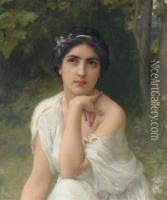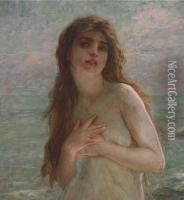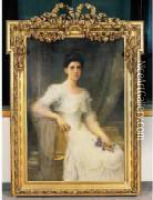Charles Amable Lenoir Paintings
Charles Amable Lenoir was a French painter, born on October 22, 1860, in Châtellaillon, a small town near La Rochelle. He is often associated with the Academic style and is known for his classical and allegorical themes, as well as his depictions of women. Lenoir showed a proclivity for art from a young age and pursued his passion by enrolling at the École des Beaux-Arts in Paris. There, he studied under the tutelage of William-Adolphe Bouguereau, a highly influential and celebrated artist of the time, known for his realistic portrayal of the human figure and mythological themes.
Lenoir's style was heavily influenced by his mentor Bouguereau, and it reflected in his meticulous attention to form and detail, with a particular emphasis on the female form. He often painted women in a serene and idealized manner, surrounded by a dreamlike ambiance. His works are characterized by their smooth brushwork and finish, which give them a nearly photographic quality.
Throughout his career, Lenoir participated in numerous exhibitions and won several awards. He exhibited at the prestigious Salon in Paris, an official art exhibition of the Académie des Beaux-Arts, where he received a third-class medal in 1886, just after leaving the École des Beaux-Arts. In 1889, he was awarded a second-class medal at the Exposition Universelle, a world's fair held in Paris that celebrated the 100th anniversary of the storming of the Bastille and the birth of the modern Republic.
Despite being well-regarded in his time and enjoying the patronage of wealthy art collectors, Charles Amable Lenoir's name is not as widely recognized today as some of his contemporaries. Nevertheless, his works continue to be appreciated for their beauty and craftsmanship. Lenoir's paintings often feature classical subjects, such as nymphs and goddesses, and he was adept at capturing the delicate interplay of light and shadow.
Charles Amable Lenoir passed away on August 1, 1926, in Paris. His legacy lives on through his artworks, which remain on display in art museums and collections around the world. He left behind a body of work that is valued for its contribution to 19th-century French art and its reflection of the Academic tradition that dominated the era.

















